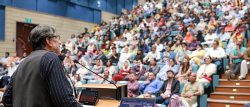At a public lecture on the possible causes of Noah’s Flood, Dr. Aaron Mulvany describes how modern research lends unexpected support to claims made by a 17th Century theologian
HABIB UNIVERSITY, November 19, 2015: At a public lecture held at Habib University’s Tariq Rafi Lecture Theater last week, the audience was taken on a fascinating, whirlwind tour of the scientific (and pseudo-scientific) discourses on the Great Flood. The Great Flood, or Toofan-e-Nooh (literally: the Storm of Noah) as it is known in Islamic cosmology, was a supposedly universal disaster in which all of humankind, except for a few divinely selected individuals, was destroyed.
Dr. Aaron Mulvany, who delivered the lecture, is an expert in water-related disasters. An accomplished multi-instrumentalist and jazz musician, Dr. Mulvany’s research and teaching interests rest broadly in disaster and policy anthropology, the Indian Ocean World, flooding and water development in the global South, and folklore.
Dr. Mulvany began his talk by providing some historical context of the flood, and the explanations offered for it by various Christian cosmologists and theologians. He explained how the world was understood to be divided between the heavens and Earth, and why scholars believed that the flood was a universal event rather than a localized one. In guiding his talk through the various theories offered by 17th Century scholars, Dr. Mulvany introduced Telluris Theoria Sacra – the Sacred Theory of the Earth – authored by Thomas Burnet, as a seminal work in ‘scientific’ explanations of the Great Flood. In the book, Burnet had argued that the earth’s crust was smooth, surrounding a hollow that contained an ‘abyss’ of water. Due to various factors, this smooth surface cracked open during the flood, letting out a flood of water from the abyss which covered the earth to a “depth of 15 cubits”.
Dr. Mulvany presented various rebuttals and criticisms to Burnet’s work by different scholars, explaining its demerits as a work of speculative cosmogony rather than based on observations of actual phenomena. Then came a surprising turning point in the discussion.
Dr. Mulvany revealed that though most of the explanations offered by Burnet can only be described as fanciful, recent geological research suggests that one of them might hold water. Dr. Mulvany was referring to a recent scientific discovery which describes ‘oceans of water’ trapped in a mineral known as ringwoodite deep beneath Earth’s mantle. The discovery reflects Burnet’s theory of the existence of an ‘abyss’ of water under the surface of the Earth, which – according to Burnet – had cracked open and spilled out onto the surface, resulting in the Great Flood.
The talk was an informative and refreshing take on a familiar tale for those who follow Abrahamic traditions. It also underscored how the natural sciences and the social sciences sometimes find common ground despite their seemingly obvious divergences.
The event was part of the School of Science and Engineering’s (SSE) Public Lecture Series. The SSE frequently invites renowned professionals and academics to share their ideas on a wide variety of interesting subjects through the forum. The series aims to enlighten, motivate and stimulate academic debate. Each event is tailored for the general public and encourages participants to think across academic disciplines.




